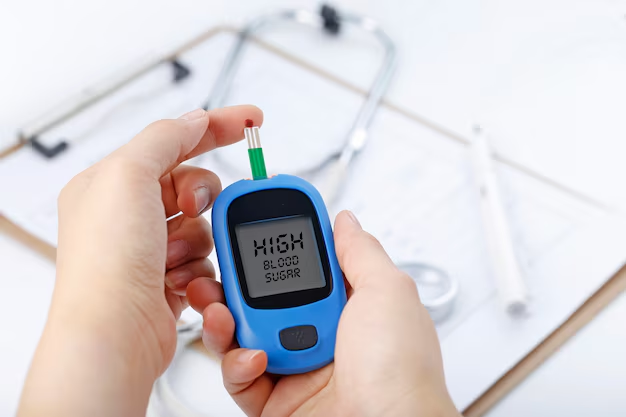Blood sugar levels refer to the concentration of glucose in your bloodstream, serving as the body’s primary energy source. Glucose derives from the foods you eat and fuels cellular functions. When blood glucose rises, the pancreas releases insulin to allow cells to absorb glucose for energy .
When blood sugar levels fall too low—a condition called hypoglycemia—you may experience shakiness, dizziness, confusion, or even difficulty speaking, because your brain is starved of energy . In contrast, chronically elevated levels—known as hyperglycemia—increase thirst, frequent urination, fatigue, and elevate long-term risks for heart disease, nerve damage, and vision problems.
Maintaining optimal blood sugar levels supports overall health. Insufficient levels impair cognitive function and energy, while excessive levels may lead to serious complications over time. Monitoring glucose, adopting balanced meals, staying active, and following medical guidance are essential steps to keep these levels within a healthy range .
Normal vs. High/Low Blood Sugar
- Normal fasting blood sugar: 70–100 mg/dL (3.9–5.6 mmol/L).
- Prediabetes: 100–125 mg/dL fasting; 140–199 mg/dL two-hour post-glucose test.
- Diabetes: ≥126 mg/dL fasting; ≥200 mg/dL two hours post-glucose drink.
The American Diabetes Association (ADA) encourages adults with diabetes to aim for:
- Pre-meal: 80–130 mg/dL
- 1–2 hours after eating: <180 mg/dL
- A1C below 7%, equating to average glucose <154 mg/dL.
Why Monitoring Matters

Tracking blood sugar levels using finger‑prick meters or continuous glucose monitors (CGMs) provides critical insight into glucose trends throughout the day. Rather than a single snapshot, regular monitoring reveals how your levels respond to meals, exercise, medication, stress, or illness—helping to optimize your management strategy.
CGMs offer continuous, real-time data and alerts for high or low glucose, empowering timely adjustments. They also enable “time in range” analysis—tracking the hours your blood sugar levels stay within target—helping to reduce complications and improve overall control.
Informed by regular monitoring, you can tailor meal timing, nutrient composition, insulin or medication dosing, and physical activity. For example, adjusting carbs or insulin around exercise prevents dips or spikes. These data-driven decisions translate into better daily glucose stability and long‑term health outcomes .
Top 8 Tips to Manage Blood Sugar Levels
1. Choose Carbs Wisely
Optimizing Blood Sugar Levels with Low-Glycemic, High-Fiber Carbohydrates
Maintaining stable blood sugar levels is crucial for overall health, especially for individuals managing diabetes or prediabetes. One effective strategy is to prioritize low-glycemic, high-fiber carbohydrates in your diet. These foods are digested more slowly, leading to gradual increases in blood sugar levels, which helps in maintaining steady energy and reducing the risk of spikes and crashes.
Benefits of Low-Glycemic, High-Fiber Carbohydrates
Incorporating foods like whole grains, legumes, vegetables, and certain fruits into your meals can provide numerous benefits. For instance, whole grains such as oats and quinoa are rich in soluble fiber, which not only aids in digestion but also helps regulate blood sugar levels by slowing the absorption of glucose. Legumes like lentils and chickpeas are excellent sources of plant-based protein and fiber, contributing to better blood sugar control. Non-starchy vegetables, including leafy greens and cruciferous vegetables, are low in carbohydrates and high in fiber, making them ideal choices for managing blood sugar levels.Incorporating These Foods into Your Diet
To effectively manage blood sugar levels, consider replacing refined carbohydrates with their low-glycemic, high-fiber counterparts. For example, choose whole-grain bread over white bread, opt for brown rice instead of white rice, and include a variety of legumes and non-starchy vegetables in your meals. Additionally, pairing these foods with lean proteins and healthy fats can further stabilize blood sugar levels and promote overall health.
2. Prioritize Protein and Healthy Fats
Maintaining stable blood sugar levels is crucial for overall health. Incorporating protein and healthy fats into each meal can play a significant role in achieving this balance. These nutrients not only provide essential energy but also help regulate glucose absorption, preventing rapid spikes and crashes.
The Role of Protein and Healthy Fats

Protein-rich foods such as lean meats, fish, eggs, and legumes slow down the digestion process, leading to a gradual release of glucose into the bloodstream. Similarly, healthy fats found in olive oil, nuts, and fatty fish like salmon and sardines contribute to this effect. These fats improve insulin sensitivity and reduce inflammation, further supporting blood sugar control.
Practical Tips for Incorporation
To effectively manage blood sugar levels, consider the following strategies:
- Breakfast: Pair eggs or Greek yogurt with whole-grain toast and avocado.
- Lunch: Include grilled chicken or chickpeas in a salad dressed with olive oil.
- Snacks: Opt for a handful of almonds or walnuts.
- Dinner: Enjoy a serving of fatty fish with steamed vegetables and quinoa.
By consistently including these nutrient-dense foods in your meals, you can enhance satiety, stabilize blood sugar levels, and support overall metabolic health.
3. Stay Active Daily
Maintaining balanced blood sugar levels is crucial for overall health, especially for individuals managing diabetes or prediabetes. Regular physical activity plays a significant role in achieving this balance. The American Diabetes Association recommends at least 150 minutes of moderate-intensity aerobic exercise per week, along with strength training exercises twice a week, to improve glycemic control and reduce the risk of cardiovascular diseases.
Benefits of Post-Meal Physical Activity
Engaging in physical activity after meals, particularly post-meal walks, can be particularly effective in managing blood sugar levels. Studies have shown that even brief periods of walking after meals can significantly lower postprandial blood glucose levels. This approach enhances glucose uptake by muscles and improves insulin sensitivity, contributing to better overall blood sugar control.
Incorporating Strength Training

In addition to aerobic exercises, strength training is essential for managing blood sugar levels. Building muscle mass through activities like weight lifting or resistance exercises helps the body utilize glucose more efficiently. Strength training also supports weight management, reduces visceral fat, and enhances metabolic health, all of which are beneficial for blood sugar regulation.
Conclusion
Regular physical activity plays a key role in managing blood sugar levels. Whether you’re trying to prevent diabetes or manage an existing condition, integrating exercise into your daily routine can make a big difference. Activities like walking, jogging, swimming, and biking (aerobic exercises) help your body use insulin more efficiently, allowing glucose to enter your cells and be used for energy instead of building up in your bloodstream.
Strength training—like lifting weights or using resistance bands—is equally important. It builds muscle, and more muscle means better glucose uptake and storage. Even simple post-meal walks can help lower blood sugar spikes after eating by encouraging your muscles to use glucose more effectively.
Incorporating a mix of aerobic and resistance exercises several times a week can improve insulin sensitivity, boost energy, and promote overall health. However, it’s essential to listen to your body. Start slow and gradually increase your activity level, especially if you’re new to exercise or dealing with a medical condition. Always consult a healthcare provider before beginning a new fitness program.
Consistency is key. Even short bursts of movement throughout the day can have a positive effect on blood sugar levels. Staying active also reduces stress, which is another major factor in blood sugar imbalance. Over time, regular exercise, paired with a balanced diet, can help you achieve more stable glucose levels, prevent complications, and support long-term wellness.
Remember, you don’t need intense workouts to see benefits—gentle, consistent movement is often the best place to start. Make exercise a part of your daily lifestyle to keep your blood sugar levels in check and enjoy better energy, mood, and health.
4. Stay Hydrated
Maintaining optimal hydration is essential for regulating blood sugar levels. Drinking adequate water supports kidney function, enabling the kidneys to efficiently filter and eliminate excess glucose from the bloodstream. When the body is well-hydrated, it can more effectively manage blood sugar concentrations, reducing the risk of hyperglycemia.
Consequences of Dehydration on Blood Sugar Levels
Dehydration can lead to elevated blood sugar levels. When the body loses more fluids than it takes in, blood volume decreases, making the blood more concentrated. This concentration results in higher blood glucose levels. Additionally, dehydration can impair kidney function, reducing the kidneys’ ability to filter and excrete excess glucose, further exacerbating high blood sugar levels.
Strategies to Maintain Proper Hydration
To support blood sugar regulation, it’s crucial to stay adequately hydrated. Aim to drink sufficient water throughout the day, adjusting intake based on activity levels and environmental conditions. Incorporating hydrating foods like cucumbers, watermelon, and citrus fruits can also contribute to overall fluid intake. Monitoring fluid intake and recognizing signs of dehydration, such as dry mouth, fatigue, and dark urine, can help maintain balanced blood sugar levels.
5. Monitor Portion Sizes and Meal Frequency
Maintaining consistent blood sugar levels is crucial for overall health, particularly for individuals managing diabetes or prediabetes. One effective strategy is to consume smaller, balanced meals every 3–5 hours. This approach helps regulate glucose levels by providing a steady supply of nutrients, preventing the spikes and crashes associated with irregular eating patterns.
Risks of Skipping Meals on Blood Sugar Regulation
Skipping meals can disrupt blood sugar balance, leading to fluctuations that may be harmful. For instance, omitting breakfast has been shown to increase postprandial hyperglycemia after lunch, even in healthy individuals. This inconsistency can impair insulin response and make blood sugar control more challenging.
Benefits of Regular, Balanced Meals

Eating at regular intervals with balanced meals, including proteins, healthy fats, and fiber-rich carbohydrates, supports stable blood sugar levels. This practice enhances insulin sensitivity and reduces the risk of long-term complications associated with blood sugar imbalances. Incorporating this habit into daily life can lead to improved energy levels, mood stability, and overall metabolic health.
In conclusion, adopting a routine of consuming smaller, balanced meals every 3–5 hours is an effective strategy for maintaining stable blood sugar levels. Avoiding meal skipping ensures consistent nutrient intake, supporting better glucose regulation and reducing health risks.
6. Manage Stress and Sleep
Stress triggers the release of cortisol, a hormone that prepares the body for a “fight-or-flight” response. While this is beneficial in acute situations, chronic stress leads to prolonged elevated cortisol levels, which can increase blood glucose levels. This effect is particularly concerning for individuals with diabetes or those at risk, as it can impair insulin sensitivity and hinder effective blood sugar regulation.
Effective Stress Management Techniques
Incorporating stress-reducing practices into daily routines can help mitigate the adverse effects of cortisol on blood sugar levels. Yoga, meditation, and deep breathing exercises are particularly effective. These activities activate the parasympathetic nervous system, promoting relaxation and reducing cortisol production. Regular engagement in these practices has been shown to improve insulin sensitivity and lower blood glucose levels.
The Importance of Quality Sleep
Adequate sleep is another crucial factor in managing stress and blood sugar levels. Poor sleep quality or insufficient sleep can elevate cortisol levels, leading to increased blood glucose. Aim for 7–9 hours of restful sleep per night to support hormonal balance and metabolic health. Establishing a consistent sleep schedule and creating a calming bedtime routine can enhance sleep quality.
7. Add Targeted Foods & Supplements
- Cinnamon, fenugreek, chia, and amla may help moderate spikes and boost insulin sensitivit.
- Apple cider vinegar before meals can reduce post-meal glucose peaks—but consult your doctor due to acidity concerns .
8. Regularly Monitor and Review
Regular monitoring of blood glucose levels is essential for effective diabetes management. Daily self-testing provides real-time insights into how meals, exercise, and medications affect blood sugar. This proactive approach allows individuals to make immediate adjustments, preventing dangerous fluctuations like hypoglycemia or hyperglycemia In addition to daily monitoring, the A1C test offers a broader perspective by measuring average blood glucose levels over the past two to three months. This test is crucial for assessing long-term glucose control and adjusting treatment plans accordingly. For most individuals with diabetes, the American Diabetes Association recommends having an A1C test at least twice a year.
Regular consultations with healthcare providers ensure that monitoring strategies align with individual health needs. These discussions help tailor treatment plans, incorporate lifestyle changes, and address any concerns, leading to more effective blood sugar management.
Practical Strategies & Sample Day
Morning
- Drink water + apple cider vinegar
- Breakfast: oats + Greek yogurt + berries + cinnamon
Midday
- Lunch: salad with beans, avocado, olive oil
- 10-minute walk post-meal
Afternoon Snack
- Nuts or fruit + protein (e.g., milk or yogurt)
Evening
- Balanced dinner – whole grains, veggies, lean protein
- 15-minute family walk afterward
Night Wind‑down
- No screens before bed; light stretching or mindfulness
Advanced Tools & Support
- CGM offers real-time glucose data and trends.
- Digital apps help track meals, glucose, and activity .
- Structured programs like CDC’s National Diabetes Prevention Program can reduce progression to diabetes by up to 58%.
Conclusion
Maintaining healthy blood sugar levels is essential for overall well-being. Whether you’re managing diabetes or simply trying to live a healthier lifestyle, knowing how your blood sugar works can help you make better decisions every day. Blood sugar affects your energy, mood, focus, and long-term health. When it stays balanced, you feel more active, focused, and less likely to develop serious complications like heart disease or nerve damage.
It’s important to understand what causes your blood sugar to rise or fall. Things like the food you eat, how much you move, stress levels, and sleep patterns all play a role. By making small but consistent changes—such as eating balanced meals, choosing whole foods, exercising regularly, and staying hydrated—you can take control of your blood sugar naturally. Monitoring your levels, as recommended by your healthcare provider, also helps you stay aware and make adjustments if needed.
In the long run, balanced blood sugar levels support better heart health, improved brain function, and reduced risk of chronic diseases. Whether you are preventing diabetes or managing it, knowledge is your strongest tool. Stay informed, be consistent, and listen to your body. With time and effort, you can build a healthy lifestyle that keeps your blood sugar in check and your body thriving.
- Smart nutrition (low-GI carbs, fibre, healthy fats)
- Regular physical activity and hydration
- Stress and sleep management
- Thoughtful addition of supportive foods and supplements
- Routine monitoring and healthcare collaboration
Together, these eight tips offer a holistic approach to stable glucose, sustained energy, and long-term well-being.
FAQ
1. What are normal blood sugar levels?
Normal fasting blood sugar is between 70–99 mg/dL, and less than 140 mg/dL two hours after eating.
2. What causes high blood sugar levels?
High blood sugar, or hyperglycemia, can be caused by eating too much sugar or carbs, lack of exercise, stress, or insulin resistance.
3. What are the symptoms of high blood sugar?
Common symptoms include frequent urination, increased thirst, fatigue, blurred vision, and headaches.
4. How can I lower my blood sugar quickly?
You can lower blood sugar by exercising, drinking water, and avoiding sugary foods. In some cases, medication may be needed.
5. What is low blood sugar and what causes it?
Low blood sugar, or hypoglycemia, happens when blood glucose drops below 70 mg/dL. It can be caused by skipping meals or taking too much insulin.
6. How often should I check my blood sugar?
If you have diabetes, your doctor may recommend checking 1–4 times a day. Always follow your healthcare provider’s advice.





